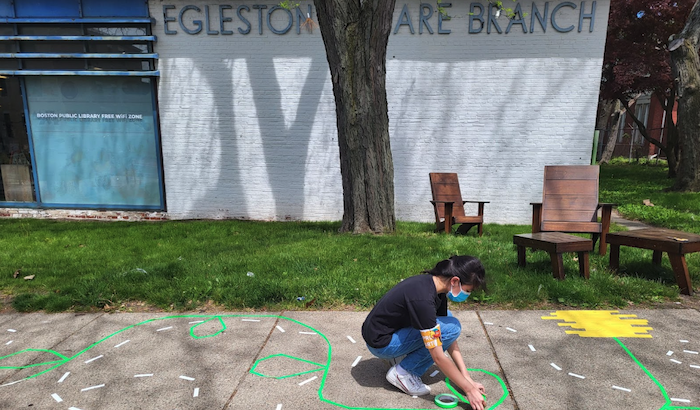
“In the end, what we did was have everyone write about how the housing crisis affects them personally.”
Egleston Square, which straddles Roxbury Crossing and Jamaica Plain, will be home to two new public art installations by artists working with the Urbano Project, all centered around the theme of democracy.
Artists Krystle Brown and Ponnapa Prakkamakul each led a workshop of youth and adults to collaborate on their respective projects going up this month. In her installation, Brown wanted to address housing insecurity, while Prakkamakul said she worked with students to test the boundaries of public spaces through sidewalk games.
The Urbano Project will celebrate the installation on June 18 at 11am at the Egleston branch of the Boston Public Library. Both artists and their cohorts of artists will present their work on a walking tour after a presentation at the library.
Brown’s project, “Calling Home,” takes the form of a phone booth that doesn’t have a phone. Instead, viewers can scan a QR code to find and read stories of real people who face housing insecurity. The artist said the theme made her wonder how people could be unhoused in a so-called democracy.
Walking around Egleston Square, Brown and eight participants reflected on how the area has changed, psychogeography, and their own personal experiences during the 10-week workshop.
The Urbano Project normally works with children and teens, but Brown said she wanted to expand their reach and impact. Ultimately, participants ranging from those in the college age group to people in their late-30s were compensated for their time reflecting with Brown on the housing crisis.
“We’re not getting too abstract and talking distantly about the subject, that it’s always how it relates back to the person because that’s the most important part,” Brown said. “In the end, what we did was have everyone write about how the housing crisis affects them personally.”
Brown is also working on printing a phone book to put in the booth with a Spanish translation, so it will be accessible to an additional community in the neighborhood. Prakkamakul’s game-oriented installation, “Message From a Sidewalk,” also promoted accessibility; her youth workshop, which collaborated for the last month and a half, used hopscotch to demonstrate how games are similar to our democracy.
“It’s like a community rule that everyone accepts and plays together with,” Prakkamakul said. “I have these artists think about a set of rules … and then (ask) if that’s a fair game, or how can you make it more accessible? How do you invite people to change your rules if they disagree?”
María Fernanda Mancera, the programs and exhibition manager at the Urbano Project, said the theme is a reflection of a turbulent political climate that includes issues such as women’s rights and environmental and racial justice.
“We just thought that stressing the importance of democratic processes was very important for the times,” she said. “Our main interest was understanding how art could play a role in facilitating those democratic processes.”
Prakkamakul said the hopscotch installation can be a time for viewers, hopefully as participants in the game, to interact with the public space and reflect.
“I think how we used sidewalks in the past is very different from now,” the artist said. “The sidewalk had been a place that neighbors may feel like extended living rooms. A lot of that disappeared, people feeling unsafe on the sidewalk.”
Brown, who has her own personal experience with housing insecurity, said the installation will show how common the crisis is around the country and in Boston.
“I think that it’s something that is affecting all people, except for the very wealthy,” Brown said. “To me, if people don’t have a place to live or a secure place to live, how can we say we live in a democracy?”
Register for both shows here.
Molly Farrar is a junior studying cello performance and journalism at Boston University. She is originally from Southern Illinois and writes about music and culture.

